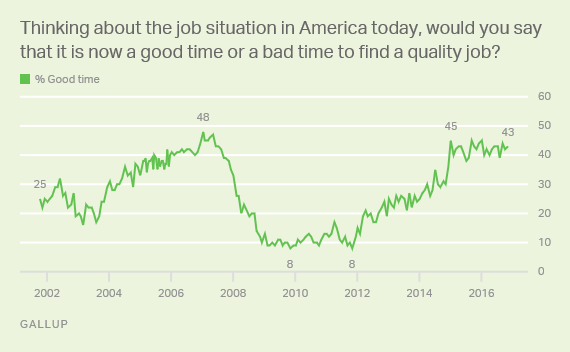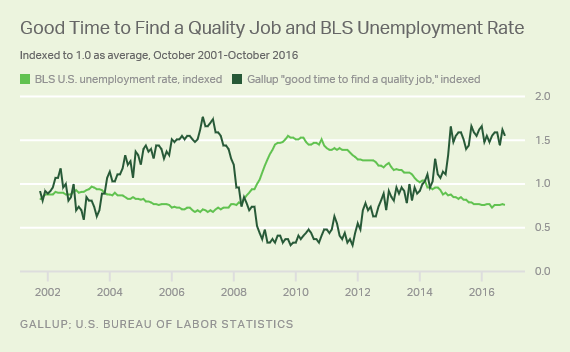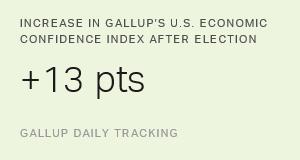Story Highlights
- 43% say now is a good time to find a quality job
- This is roughly the same as Gallup has measured since early 2015
- Views of the job market are highly related to U.S. unemployment rate
PRINCETON, N.J. -- Forty-three percent of Americans currently say now is a good time to find a quality job. This percentage, from a Gallup poll conducted right after the election, is essentially the same as the 42% recorded in October and about average for the measure since early 2015.

Americans' views of the job market have gone through several phases since Gallup began measuring them each month in October 2001, when roughly a quarter saw positive job market conditions. Attitudes about jobs improved from 2004 through early 2007, including the 15-year high of 48% in January 2007. Then, with the start of the 2007-2009 recession, perceptions of the job market fell dramatically, bottoming out at 8% in November 2009 and remaining low through much of 2011. Views improved from 2012 through the beginning of 2015 and have been fairly stable since, in the low- to mid-40% range.
Just as Americans' impressions of the job market are the same this month compared with October, there was no short-term change in views when Barack Obama was elected for the first time in November 2008.
Americans' Views of Job Market Closely Mirror BLS Unemployment Rate
Gallup's measure of Americans' subjective views about the job market is designed to augment the objective economic data from government and other sources. But the reality is that Americans' perceptions track closely with the unemployment rate that the U.S. government publishes each month. Views that it is a good time to find a quality job rise when the unemployment rate falls, are generally stable when the rate is stable and drop when the rate goes up.
The accompanying chart displays trends on both Gallup's quality job measure and the monthly Bureau of Labor Statistics (BLS) unemployment rate. Because the two measures are on different scales, each has been indexed to its average over the October 2001 to October 2016 period, with 1.0 representing the average for each.

The overall correlation between the monthly BLS unemployment rate and Americans' belief that it is a good time to find a quality job is -.88.
The strong relationship between these measures suggests Americans may be aware of the official, widely reported employment rate when it comes out each month, and may consider that rate when asked to assess the job market. Broader reporting about the economy's health, such as GDP growth, may influence the public's views as well. Americans may also more directly assess the jobs-related reality they see around them daily, the same reality that is reflected when the government assesses employment trends each month.
Whatever the underlying reasons, the key takeaway is that Americans' collective views of the job market appear to be mostly grounded in employment reality -- at least as measured by the government.
Bottom Line
President-elect Donald Trump maintained during his campaign that Americans were experiencing economic malaise, including increased worry about the availability of good jobs. The percentage of Americans who say it is a good time to find a quality job (43%) is not high on an absolute basis but is generally in sync with what one would expect based on the patterns over the past 15 years -- given an unemployment rate hovering near 5%. Americans do not appear to be in an unusual funk, but rather reflect the objective reality in the same way they have since 2001.
If the unemployment rate drops in the months ahead, history shows that the percentage saying it is a good time to find a quality job could rise closer to 50%. The most positive view of the job market Gallup has measured was 48% in early 2007, when the unemployment rate was hovering in the mid-4% range.
Historical data are available in Gallup Analytics.
Survey Methods
Results for this Gallup poll are based on telephone interviews conducted Nov. 9-13, 2016, with a random sample of 1,019 adults, aged 18 and older, living in all 50 U.S. states and the District of Columbia. For results based on the total sample of national adults, the margin of sampling error is ±4 percentage points at the 95% confidence level. All reported margins of sampling error include computed design effects for weighting.
Each sample of national adults includes a minimum quota of 60% cellphone respondents and 40% landline respondents, with additional minimum quotas by time zone within region. Landline and cellular telephone numbers are selected using random-digit-dial methods.
View survey methodology, complete question responses and trends.
Learn more about how the Gallup Poll Social Series works.




